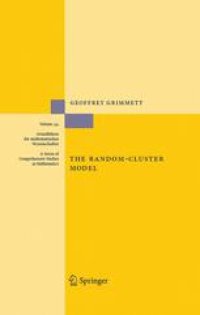
Ebook: The Random-Cluster Model
Author: Geoffrey R. Grimmett (auth.)
- Tags: Probability Theory and Stochastic Processes, Theoretical Mathematical and Computational Physics
- Series: Grundlehren der mathematischen Wissensch 333
- Year: 2006
- Publisher: Springer-Verlag Berlin Heidelberg
- Edition: 1
- Language: English
- pdf
The random-cluster model has emerged in recent years as a key tool in the mathematical study of ferromagnetism. It may be viewed as an extension of percolation to include Ising and Potts models, and its analysis is a mix of arguments from probability and geometry. This systematic study includes accounts of the subcritical and supercritical phases, together with clear statements of important open problems. There is an extensive treatment of the first-order (discontinuous) phase transition, as well as a chapter devoted to applications of the random-cluster method to other models of statistical physics.
The random-cluster model has emerged in recent years as a key tool in the mathematical study of ferromagnetism. It may be viewed as an extension of percolation to include Ising and Potts models, and its analysis is a mix of arguments from probability and geometry. This systematic study includes accounts of the subcritical and supercritical phases, together with clear statements of important open problems. There is an extensive treatment of the first-order (discontinuous) phase transition, as well as a chapter devoted to applications of the random-cluster method to other models of statistical physics.
The random-cluster model has emerged in recent years as a key tool in the mathematical study of ferromagnetism. It may be viewed as an extension of percolation to include Ising and Potts models, and its analysis is a mix of arguments from probability and geometry. This systematic study includes accounts of the subcritical and supercritical phases, together with clear statements of important open problems. There is an extensive treatment of the first-order (discontinuous) phase transition, as well as a chapter devoted to applications of the random-cluster method to other models of statistical physics.
Content:
Front Matter....Pages i-xiii
Random-Cluster Measures....Pages 1-18
Monotonic Measures....Pages 19-36
Fundamental Properties....Pages 37-66
Infinite-Volume Measures....Pages 67-97
Phase Transition....Pages 98-132
In Two Dimensions....Pages 133-166
Duality in Higher Dimensions....Pages 167-221
Dynamics of Random-Cluster Models....Pages 222-256
Flows in Poisson Graphs....Pages 257-275
On Other Graphs....Pages 276-319
Graphical Methods for Spin Systems....Pages 320-340
Back Matter....Pages 341-379
The random-cluster model has emerged in recent years as a key tool in the mathematical study of ferromagnetism. It may be viewed as an extension of percolation to include Ising and Potts models, and its analysis is a mix of arguments from probability and geometry. This systematic study includes accounts of the subcritical and supercritical phases, together with clear statements of important open problems. There is an extensive treatment of the first-order (discontinuous) phase transition, as well as a chapter devoted to applications of the random-cluster method to other models of statistical physics.
Content:
Front Matter....Pages i-xiii
Random-Cluster Measures....Pages 1-18
Monotonic Measures....Pages 19-36
Fundamental Properties....Pages 37-66
Infinite-Volume Measures....Pages 67-97
Phase Transition....Pages 98-132
In Two Dimensions....Pages 133-166
Duality in Higher Dimensions....Pages 167-221
Dynamics of Random-Cluster Models....Pages 222-256
Flows in Poisson Graphs....Pages 257-275
On Other Graphs....Pages 276-319
Graphical Methods for Spin Systems....Pages 320-340
Back Matter....Pages 341-379
....